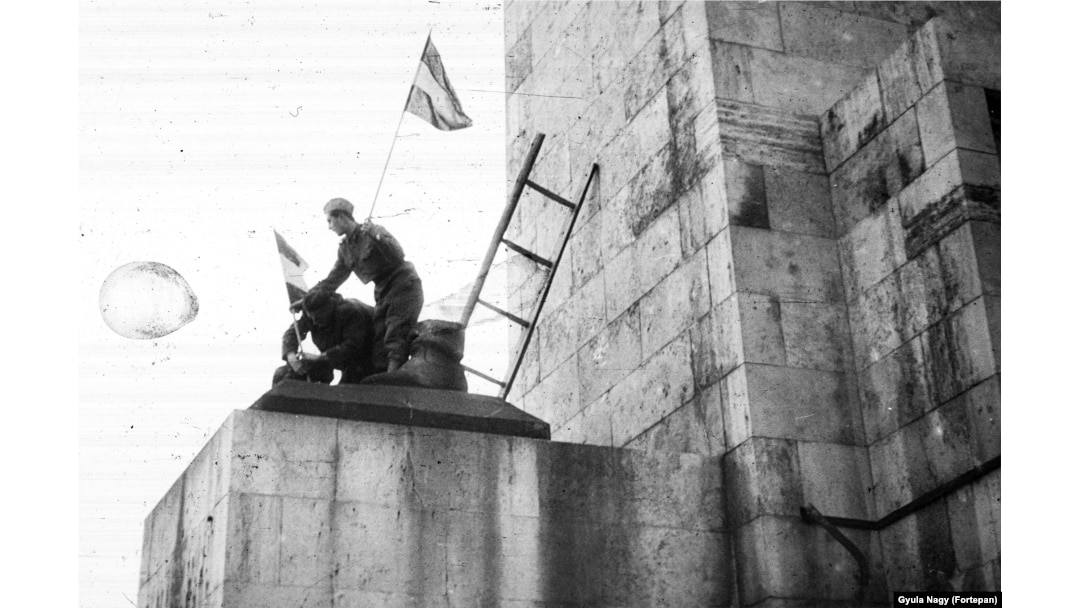On April 5, 1947, a towering figure of a woman holding a palm frond was inaugurated above Budapest, a city still largely ruined from World War II.

Images from newsreel footage of the hilltop monument show it being pieced together in 1946.
Despite its artfulness, the monument was soon viewed as an inescapable symbol of Soviet dominance for its dedication to "the memory of the liberating Soviet heroes..."

An archival photo of the liberty monument with a Soviet soldier (left) and a figure representing the fight against Nazism.
The Red Army had driven Nazi-led forces out of Hungary in the closing days of World War II, but the Kremlin-backed socialist rule that followed was deeply unpopular, and in 1956 Hungarians rose up in a bloody, short-lived revolution.

After the statue of the Soviet soldier is torn down, cameraman Miko Jozsef attaches a Hungarian flag to the remaining boots of the statue with the help of a young soldier.
During the uprising, crowds gathered under the base of the liberty monument and tore down an accompanying figure of a Soviet soldier, but the female figure above the soldier survived and stands today with an updated inscription to "the memory of all those who sacrificed their lives for the independence, freedom, and prosperity of Hungary."
Erzsebet Gaal photographed while in her 20s
The model for the monument's centerpiece was a woman named Erzsebet Gaal, who was 28 years old when she happened to be spotted on the street by Zsigmond Kisfaludi Strobl. The sculptor told her he was looking for a woman with a "beautiful posture, a proportionate figure, and a clear eye," which he saw in her.
Gaal was convinced to stand for several modeling sessions, holding a palm frond representing peace, in front of a fan that billowed her dress.
Budapest’s liberty monument photographed in February 2022.
Miklos Vincze, a Budapest journalist and historian who studied the life story of Gaal, told RFE/RL that although she wasn't paid for the use of her image, the young woman at first enjoyed a degree of official attention and respect: "She was at every big parade in Budapest, and she shook hands with [Russian cosmonaut] Yuri Gagarin."
But by the late 1980s, Vincze says propaganda events were seen as passe, and the Hungarian authorities "simply forgot Erzsebet," who, in the changing political landscape, was "no longer needed."
Sculptor Zsigmond Kisfaludi Strobl with Erzsebet Gaal, who holds a model of the liberty monument in 1965.
In 1981, Gaal's husband, Tihamer, with whom she had a daughter, died. The widow, who then worked as an X-ray assistant in the western city of Sopron, became increasingly poor and embittered. In a 1984 interview ,she proclaimed that she would like to "tear down the statue, or throw rotten eggs at it" and complained of being "in a rut, lonely, and ignored by comrades who don't help or even visit."
The tombstone of Erzsebet Gaal in Sopron, western Hungary, which she shares with her husband.
In the late 1980s, Gaal's financial situation became desperate and Vincze says the head of the sanatorium where she worked and lived as an "unauthorized tenant" attempted to have her kicked out. Before Gaal was forced to make her choice of where to go, she died of unknown causes in 1989, aged 72. On her gravestone in Sopron an engraving reads, "Here lies the model for the statue of liberty."
The liberty monument on a clear day in February 2022.
Gaal's grave also includes a personal message from her daughter, Eva, who does not speak to the media. She honors her mother for becoming "an eternal person."


